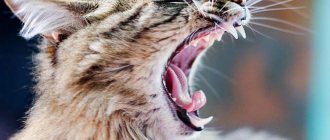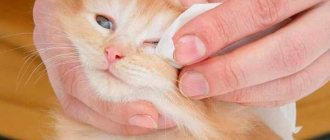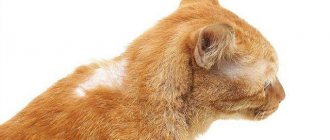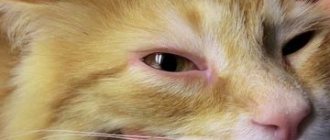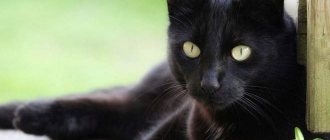For normal functioning of the organs of vision, the anterior surface of the eyeball of mammals must always be well moistened. This task is performed by the lacrimal apparatus. A cat's lacrimal glands constantly secrete a small amount of tear fluid, which has a protective and disinfectant function. The waste moisture goes into the so-called lacrimal lake, which communicates with anatomical structures - lacrimal openings. These are small holes in the corners of the eyes that lead into the tear ducts. Through them, moisture flows into the nasal cavity and evaporates under the influence of breathing.
If the animal is healthy, then there is practically no excess tear fluid. There is no discharge from the cat's eyes at all. A small amount of transparent liquid secretion may be released, which is practically invisible from the outside and does not require elimination.
If the discharge is copious, opaque, has an unpleasant odor and color, it can be assumed that there is an eye pathology. White, green, reddish, brown discharge indicates a bacterial or fungal infection. Let's look at why this happens, let's look at the main causes of pathological discharge from the eyes, find out how to treat the animal, what first aid measures are.
Cosmetic defect
Brown discharge from the corners of the eyes in cats is not always a sign of pathology. The cornea is constantly washed by tear fluid, but under certain circumstances it becomes larger.
The amount of discharge increases in strong winds, due to bright light, if the cat is in a dusty or smoky room.
The tear fluid contains substances that, when exposed to ultraviolet radiation, acquire a brownish tint. Dark discharge is most noticeable in the following cats:
- with light coat color;
- with a flattened muzzle;
- in older individuals;
- in emotional pets - when they purr, they produce copious amounts of tears or saliva.
Minor discharge, which over time turns into dried brown crusts, is not a pathology and does not threaten the cat in any way. This is just a cosmetic defect. Brown marks are usually removed using daily hygiene products.
Attention! You should not wipe your cat's eyes with hydrogen peroxide. If it comes into contact with the mucous membrane, the solution may cause irritation and discomfort.
Manifestations of pathology
Before treatment, the animal’s condition should be assessed, so pay attention to the duration and nature of eye discharge, the presence or absence of other symptoms.
Signs may be as follows:
profuse lacrimation;- swelling around the eyes;
- brown, green and yellow discharge;
- impurities of pus in the discharge.
A Scot with pathology may constantly rub his eyes.
In some cases, symptoms include:
- hyperthermia;
- copious nasal discharge;
- drowsiness;
- changes in habitual behavior;
- apathy;
- pet anxiety;
- cough.
If symptoms appear that are not normal, you should consult your veterinarian.
Types of pathological discharge from the eyes
During pathological processes, cats develop discharge that differs in color and consistency:
- Transparent. If your cat's eyes are watery but a colorless liquid exudate is coming out, this may be a sign of an allergy.
- White or light yellow. Such discharge most often occurs due to a viral or fungal infection.
- Saturated yellow or greenish (purulent) is a sign of infection with pathogenic bacteria.
- Brown or reddish discharge with a thick consistency. This color indicates that they contain red blood cells.
Features of pathology in kittens
Kittens of this breed can also be a bit teary. However, these discharges are detected only after the pet wakes up. Normally they almost never happen.
But a veterinarian will definitely be needed when the kitten has a brown or yellow-green tinge to the eye discharge. A specialist should show the animal if the eyelids are swollen or if there is excessive lacrimation.
Provoking factors in small kittens include:
intrauterine infection;- lack of vaccinations;
- congestion of the tear ducts;
- weak immune system.
If a kitten has a little clear discharge after sleep, and its eyes sparkle, then these are not pathological processes.
Causes of discharge from eyes in cats
There are many reasons why a cat has brown discharge coming from its eyes. The problem can be caused by injury, infection, inflammation or even a tumor.
Impaired outflow of tear fluid
Dacryocystitis is one of the possible causes of bloody discharge in the corners of the eyes. This is a pathology in which the passage of tear fluid through the nasolacrimal duct becomes difficult.
The reasons for obstruction are as follows:
- Inflammation of the walls of the lacrimal canal, which leads to its narrowing and blockage. As a result, fluid stagnation occurs. A pathogenic microflora develops in the lacrimal sac, and a mucous secretion mixed with blood begins to be released from the corners. The inflammatory process is accompanied by redness of the eye and discomfort. The cat becomes restless.
- Narrowing of the lacrimal opening, or stenosis. This pathology occurs in cats, which often suffer from conjunctivitis. The chronic inflammatory process helps to reduce the diameter of the lacrimal opening. As a result, fluid constantly accumulates in the eye and flows out from the inner corner. Stenosis can be not only acquired, but also congenital. In this case, the problem can only be solved through surgery.
- Injury. During active play on the street or at home, cats sometimes bump into sharp objects and injure their eyes. When the eyelids are torn or cut, the tear duct often suffers. In this case, black discharge appears from the eye because the tear fluid contains a large amount of blood. It is important to seek help from a veterinarian immediately. If necessary, he will stitch the eyelid and help restore the patency of the nasolacrimal duct.
- Tumor. If the eye becomes less mobile and hurts, and brown tears flow from the corner, this may be caused by a benign or malignant neoplasm. The presence of blood in the tear fluid indicates tissue damage. Only surgery will help with the tumor. For eye cancer, treatment with chemotherapy is mandatory.
- Foreign body in the lacrimal canal. Motes such as grains of sand, dust particles, and insects can get into a cat's eyes. Together with tears, small foreign bodies sometimes penetrate the ducts of the nasolacrimal canal, which leads to its blockage and inflammation. The cat feels discomfort when blinking and tries to wash its eye with its paw. This causes even more irritation. Treatment involves removing the foreign body by washing or bougienage, as well as the use of local antiseptics.
Infectious diseases
Inflammation of the eyes, which is often accompanied by copious brown discharge, may be one of the symptoms of an infectious disease:
- chlamydia;
- toxoplasmosis;
- panleukopenia;
- calcivirosis;
- rhinotracheitis.
With such serious illnesses, the cat’s health deteriorates. She becomes lethargic, loses appetite, body temperature rises, and her coat looks unkempt. With some infectious diseases, kittens bleed not only from the eyes, but also from the nose. The eyelids become swollen and red.
Attention! If such symptoms are detected, you should immediately seek veterinary help. If left untreated, your cat may die from a viral infection.
Brown discharge also appears with ophthalmological diseases, which can be caused by a bacterial, viral or fungal infection. These include:
- conjunctivitis – inflammation of the mucous membrane of the eye;
- blepharitis – eyelash follicles are affected;
- keratitis – inflammation of the cornea;
- anterior uveitis - infection affects the blood vessels of the eyes.
In all of these cases, a sick cat may develop brown tears from one or both eyes if the inflammation has affected the vessels and capillaries.
Other pathologies
Cats sometimes have watery eyes due to problems with their internal organs. Diabetes mellitus, kidney, liver or intestinal diseases are often accompanied by brown discharge from the organs of vision. Also, a similar problem occurs when infected with helminths.
In rare cases, tearing occurs due to dietary errors, for example, when a cat owner feeds her dry and wet food at the same time.
In Sphynxes and Cornish Rexes there is such a pathology as entropion of the eyelid, in which brown discharge also flows from the eyes. Long-haired cats “cry” when hairs get on the mucous membrane of the eyeball.
Attention! Eyes can fester in any animal, regardless of their gender or age. However, cat breeds with a flattened face - Scottish, British and Persian - are especially susceptible to this pathology, because they have a shortened nasolacrimal duct.
Breed Features
Another variant of the norm for increased mucus secretion in cats is determined by the breed. This feature occurs in cats with a flattened muzzle. This characteristic is accompanied by disruption of the nasolacrimal duct and nasopharynx. As a result, the outflow of fluid worsens and excessive accumulation occurs in the organs of vision.
Prominent representatives of these breeds are:
- "Persians";
- "British";
- Exocote;
- Scottish Fold (Scottish Fold cat);
- Manul;
- Himalayan cat.
In addition to increased mucus accumulation, these cats may experience problems associated with nasopharyngeal congestion. Snoring, frequent snorting and noisy eating are not uncommon manifestations in these breeds. Owners should carefully care for their pets and prevent the development of a pathological condition. Regular visits to the veterinarian will be helpful for this.
Diagnostics
If the owner notices brown discharge around the cat's eyes, he needs to take the pet to a veterinary clinic. In most cases, examination and history is sufficient to make a diagnosis.
Sometimes it is necessary to conduct additional tests to help rule out head and eye injuries, as well as diseases of internal organs and infectious diseases. To do this you may need to do:
- Ultrasound of the organs of vision;
- X-ray of the skull;
- blood and stool tests.
Causes
If your cat has brown discharge from the eyes, it is always a sign of health problems, but it is not always caused by an infection.
Non-infectious causes
These are congenital pathologies, hereditary diseases or acquired characteristics due to injury.
- Features of the anatomical structure of the eyelids.
Anomalies can be congenital or acquired. Typically, the eyelashes come into contact with the cornea. An example of such an anomaly is entropion of the eyelids. Also, impaired eyelash growth causes irritation of the tear duct.
May be caused by a fall or impact. As well as injuries to the nose or facial part of the skull.
- Tear duct defects
Pathologically narrow lacrimal canals or congenital obstruction of the ducts.
Treatment and prevention
Depending on the cause of inflammation, the veterinarian develops a treatment regimen for the cat:
- In some cases, local therapy using drops or ointments with antimicrobial, analgesic and anti-inflammatory effects is sufficient.
- If brown discharge appears due to congenital pathology of the eyelids, surgery is recommended.
- Surgery cannot be avoided when a cat has an eye tumor.
- If the tear ducts are clogged or blocked, rinsing helps, but if they are narrowed, surgery may be necessary.
- If a kitten is diagnosed with an infectious disease, one of the symptoms of which is purulent eyes with brown discharge, then the pet is treated not only with eye drops, but with antiviral drugs and immunostimulants.
- For helminthiasis, which is accompanied by tearing, antiparasitic drugs are used.
Types of eye drops for cats
In most cases, treatment for brown discharge involves the use of topical eye medications. These include drops and ointments. They are divided into 3 groups - antimicrobial, antibacterial and antiviral (immunomodulatory).
Antiseptic drops
Antiseptics can be used for the prevention and treatment of ophthalmic diseases:
- Ophthalmosan. A preparation based on chlorhexidine and succinic acid. These components inhibit the development of pathogenic microflora. For brown discharge in cats, use 2-3 times a day, 2 drops under the lower eyelid. The duration of the course of treatment is determined by the veterinarian.
- Lacrican. The main component is the antiseptic polysept, which prevents the proliferation of microbes. The drug also contains anesthesin, a substance with an analgesic effect. After preliminary cleaning of brown discharge, 2 drops of medicine are injected under the cat’s lower eyelid. The procedure is carried out 2 or 3 times a day for 8–10 days.
Antibacterial drops
These are drugs that destroy gram-positive and gram-negative bacteria - chlamydia, mycoplasma, staphylococcus, Pseudomonas aeruginosa, etc. These microorganisms cause inflammation of the organs of vision, which is accompanied by purulent and brown discharge. List of medications for cats:
- Tsiprovet. It is prescribed for acute or chronic conjunctivitis, keratitis, blepharitis, and corneal ulcers. The active ingredient is ciprofloxacin. Directions for use and dosage for cats: 1 drop in each eye 4 times a day; the course of treatment for brown discharge is 1–2 weeks (until complete recovery).
- Dekta-2. The active ingredient here is gentamicin. It has a wide spectrum of antibacterial action. The medicine also contains dexamethasone, a glucocorticosteroid. This is an anti-inflammatory component. Directions for use: 2-3 drops into the conjunctival sac of the eye 2-3 times a day. The course of treatment is from 5 to 10 days.
- Lakrimin aseptic. Broad-spectrum eye drops based on chloramphenicol and sodium sulfosalicylate. The drug is used for eye diseases with purulent discharge, as well as for postoperative complications and wounds of the eyelids or cornea. Directions for use: 2-3 drops 2-3 times a day for 5-7 days.
Immunomodulatory
This group includes cat drops, which are indicated for use in eye diseases caused by viral infections:
- Anandin. The drops have an immunomodulatory, anti-inflammatory and regenerating effect. For brown or purulent discharge under the cat's eyelid, administer 2 drops of medication in the morning and evening. The course of treatment is from 5 to 7 days.
- Maxidin. The drug is based on an organic compound of germanium, which has high antiviral activity, and also has an anti-inflammatory and regenerating effect. Drops are used to treat conjunctivitis and keratitis of an infectious and allergic nature. Directions for use: 1 or 2 drops under each eyelid 2 times a day until the symptoms of the disease disappear.
How to rinse and apply eye drops at home
Before using medicinal products, it is necessary to clean the cat's eyelids of brown discharge. To carry out the procedure, you will need the help of another person, because the cat will struggle. It is necessary to prepare in advance clean cotton pads (5-6 pieces for each eye), as well as a means for hygienic treatment:
- strained chamomile decoction;
- furatsilin solution – 1 tablet per glass of water;
- weak solution of boric acid.
If none of the above is at hand, you can rinse your eyes with warm boiled water. A cotton pad is generously moistened and gently wiped over the cat's eyelids in the direction from the outer corner of the eye to the inner.
Dirty sponges are put aside - you need to take a clean one every time. It is important to remove all brown discharge and crusts. Only after this the eyes are instilled with a medicinal composition.
Attention! The eyelid cleaning procedure is carried out before each use of eye drops.
What to do and how to treat?
Before visiting the doctor, you can wipe your pet’s eyes with a herbal decoction.
If the owners notice that the cat’s eyes are festering and other alarming symptoms are recorded, then they should not delay a visit to the veterinarian. At home, it is possible to treat the visual organs with decoctions based on chamomile, calendula and other medicinal herbs that have antimicrobial and antiseptic effects. After conducting a comprehensive examination and identifying the root cause of the problem, the pet is prescribed medications.
You should not apply any eye drops to cats for pus at your own discretion, since there is a high probability of worsening the disease and developing complications. In most cases, it is possible to cope with unpleasant symptoms in a pet with the help of the following ophthalmic medications:
- "Iris";
- "Leopard";
- "Diamond Eyes";
- "Levomycetin".
For a speedy recovery of your pet and elimination of pathological exudate, you need to know how to properly apply eye drops to a cat. To do this, the pet's head is fixed so that the visual organs are directed upward. It is better to perform the manipulation together to ensure reliable fixation of the cat. The pipette must be kept at a distance of 2 centimeters from the eye, so that in case of sudden movement it does not damage the mucous membrane of the eye. Treatment is carried out until the animal recovers completely, until the discharge completely stops appearing.
Preventive measures
To prevent brown discharge from appearing again in a cat, the owner of the animal should pay attention to the prevention of ophthalmological diseases. What exactly needs to be done:
- accustom your pet to good quality food;
- In the room where the cat lives, it is advisable not to use deodorants or smoke;
- adhere to the vaccination schedule;
- carry out antiparasitic treatment in a timely manner;
- protect the cat from contact with sick animals;
- support the cat’s immunity with vitamin and mineral complexes;
- Wipe your pet's eyes daily with hygiene lotion.
The health of the pet is in the hands of the owner. And if a cat has brown or reddish discharge in the corners of its eyes, it is better not to waste time, but to contact a veterinary clinic. If left untreated, purulent inflammation can lead to vision loss.
Symptoms of anxiety
If any abnormality occurs, the cat owner will immediately see changes in the quality of the fluid released. In order not to aggravate the animal’s condition and not to miss a serious illness, you should contact a specialist as soon as possible if you have the following symptoms:
- the amount of discharge has increased significantly and does not go away within several days;
- the animal has permanent crusts under the eyes;
- the fur around the eyes is wet or has dried mucus;
- the pet constantly washes itself and rubs its eyes;
- other signs of the disease occur: loss of appetite, lethargy, changes in behavior.
Serous conjunctivitis:
With serous conjunctivitis, moderate mucous discharge appears, the conjunctiva is pink and slightly swollen. The discharge is clear and watery and is caused by physical irritants such as wind, cold weather, dust or various allergens.
Serous conjunctivitis may be the first symptom of feline viral respiratory disease (rhinotracheitis), chlamydia or mycoplasmosis.
If adequate treatment is not provided, serous conjunctivitis develops into a more severe form - purulent conjunctivitis.
| Purulent conjunctivitis. Cat, 5 months |
How to treat the eyes of small kittens
In the first months of life, baby animals are not able to care for themselves independently. Inflammation of the kitten's eye mucosa often occurs with the release of brown secretion.
The pathology also manifests itself in blind kittens. They undergo regular eye rinsing (up to 6 times daily) until the age of three months.
To clean, take a cotton swab soaked in antiseptic. The kitten's eyelids are carefully separated (if the eyes have already opened) and the procedure is carried out.
Washing is done in the same way as for adult animals. It is important to consult with a specialist about the need to prescribe antibiotic therapy.





